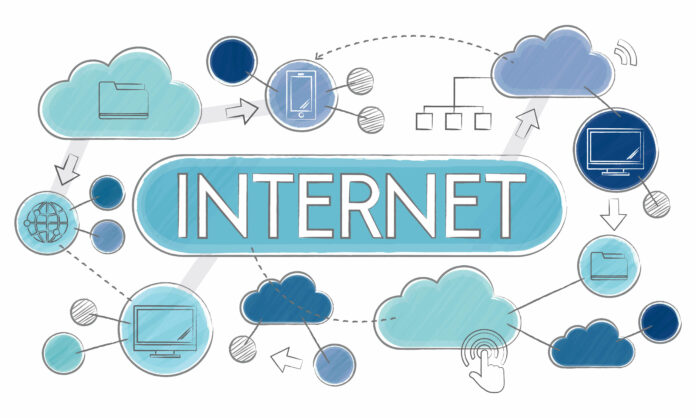The internet is an incredible technology that has changed our lives in many ways. From connecting with friends and family to accessing endless amounts of information, the internet is a big part of our daily routines.
But have you ever questioned when was created the internet, who created the internet, or how it all started? Let’s take a journey through the history of the internet to understand its creation and evolution.
When Was Created the Internet?
The internet as we know it today wasn’t built in a day. Its creation was a gradual process that spanned several decades.
The idea of creating a network of computers that could communicate with each other started to take shape in the late 1950s and early 1960s. However, the actual development of the internet began in the late 1960s.
In 1969, the Advanced Research Projects Agency Network (ARPANET) was established. ARPANET is often considered the predecessor to the modern internet. It was the first network to use the packet-switching technology, which is essential for the internet to function. This was a significant milestone in the timeline of when the internet was created.
Who Created the Internet?
The creation of the internet wasn’t the work of a single person but rather a collaborative effort by many brilliant minds. Among the key figures who created the internet were:
- J.C.R. Licklider: Known as the “Johnny Appleseed” of computing, Licklider was an early visionary of the internet. He imagined a network of computers that could share information.
- Leonard Kleinrock: He developed the theory of packet switching, which is the fundamental technology behind the internet.
- Robert Taylor: He played a crucial role in securing funding for ARPANET and overseeing its development.
- Vint Cerf and Bob Kahn: Often called the “fathers of the internet,” they developed the Transmission Control Protocol/Internet Protocol (TCP/IP), which is the foundation of internet communication.
The Early Days of ARPANET
ARPANET was the first network to implement the concept of packet switching. It initially connected four research institutions: the University of California, Los Angeles (UCLA), the Stanford Research Institute (SRI), the University of Utah, and the University of California, Santa Barbara (UCSB).
On October 29, 1969, the first message was sent over ARPANET from UCLA to SRI. The message was supposed to be “LOGIN,” but the system crashed after the first two letters, so the first message was “LO.”
The Birth of the World Wide Web
While ARPANET and TCP/IP protocols were essential for the creation of the internet, the World Wide Web (WWW) made the internet accessible to the general public. In 1989, Tim Berners-Lee, a British scientist, proposed the idea of the World Wide Web. He developed the first web browser and web server, making it possible to create and view web pages.
The World Wide Web was officially launched to the public in 1991, and it revolutionized how we use the internet. It made it easy for anyone to access and share information, leading to the internet boom of the 1990s.
The Growth of ARPANET and the Birth of Email
As more institutions joined ARPANET, the network grew, and so did the need for better communication tools. One of the earliest and most significant developments was the creation of email. In 1971, Ray Tomlinson sent the first email.
He used the “@” symbol to separate the user’s name from the computer’s name, a practice still used in email addresses today. Email quickly became popular on ARPANET, as it allowed users to send messages to each other easily.
From ARPANET to the Internet
Throughout the 1970s and early 1980s, ARPANET continued to grow. However, it was still primarily used by researchers and academics. The development of the TCP/IP protocols by Vint Cerf and Bob Kahn was a game-changer. These protocols allowed different types of networks to interconnect, creating a true “network of networks.” Today, you can connect yourself in no time to the internet with the help of 4G or 5G technology.
On January 1, 1983, ARPANET officially switched to the TCP/IP protocols, and this date is often considered the birth of the modern internet. This switch allowed various smaller networks to join, paving the way for a vast, interconnected global network.

The Birth of the Domain Name System (DNS)
As the network expanded, it became clear that a system was needed to manage the growing number of computers connected to the internet. In 1984, the Domain Name System (DNS) was introduced. DNS translated human-friendly domain names (like www.example.com) into IP addresses that computers could understand. This made it much easier for people to navigate the internet and access websites.
The World Wide Web Revolution
While the internet continued to grow throughout the 1980s, it was still mainly used by scientists and researchers. That all changed in 1989 when Tim Berners-Lee proposed the idea of the World Wide Web. Berners-Lee’s vision was to create a system of linked documents that could be accessed via the internet.
In 1990, Berners-Lee developed the first web browser, called WorldWideWeb, and the first web server. The World Wide Web was launched to the public in 1991, making it much easier for people to access and share information online. This marked the beginning of the internet as we know it today.
The Commercialization of the Internet
The 1990s saw the rapid commercialization of the internet. Businesses quickly recognized the potential of the World Wide Web, and many new companies were founded to capitalize on this emerging technology.
Internet Service Providers (ISPs) began offering access to the internet to the general public, and web browsers like Netscape Navigator and Microsoft Internet Explorer made it easier for people to explore the web.
The Dot-Com Boom and Bust
The late 1990s saw a massive surge in internet-related businesses, often referred to as the dot-com boom. Companies rushed to establish an online presence, and investors poured money into internet startups. This period of rapid growth and speculation led to the creation of many innovative companies, but it also resulted in a market bubble.
In 2000, the dot-com bubble burst, leading to the collapse of many internet companies. Despite this setback, the internet continued to grow and evolve. Successful companies like Amazon and Google emerged from this period, demonstrating the long-term potential of the internet.
The Rise of Social Media and Mobile Internet
In the 2000s, the internet became even more integral to our daily lives with the rise of social media platforms. Websites like MySpace, Facebook, Twitter, and Instagram changed how we communicate and share information. Social media allowed people to connect with friends and family, share photos and videos, and stay updated on current events.
The advent of smartphones and mobile internet further revolutionized how we use the internet. With devices like the iPhone, people could access the internet from anywhere, making it an even more indispensable part of modern life.
The Impact of the Internet on Society
The internet has fundamentally transformed our world in profound ways, affecting everything from how we communicate and conduct business to how we learn and entertain ourselves.

Revolutionizing Communication
One of the most significant impacts of the internet is its effect on communication. Email, instant messaging, and social media platforms have revolutionized how we interact with others. We can now connect with people across the globe instantly, share thoughts and ideas, and collaborate on projects regardless of geographical boundaries. The internet has made communication more accessible, efficient, and inclusive than ever before.
Transforming Education
The internet has democratized access to education. Online learning platforms, such as Coursera, edX, and Khan Academy, offer courses and resources on a wide range of subjects, often for free or at a lower cost than traditional education. Students can access lectures, videos, and interactive materials from renowned institutions and educators worldwide, expanding learning opportunities beyond the confines of traditional classrooms.
Additionally, educational resources like Wikipedia provide instant access to vast amounts of information, empowering students and educators alike to deepen their knowledge on any topic of interest. The internet has transformed how we learn, making education more flexible, personalized, and accessible to learners of all ages.
Revolutionizing Business and Commerce
The internet has reshaped the business landscape, enabling companies to reach global markets and operate more efficiently. E-commerce platforms like Amazon, Alibaba, and eBay have revolutionized retail, allowing consumers to shop for goods and services from anywhere at any time. Small businesses can now compete on a global scale, reaching customers around the world through their online storefronts.
Moreover, the internet has transformed marketing and advertising, offering targeted and personalized campaigns based on user preferences and behavior. Digital marketing strategies, including search engine optimization (SEO), social media marketing, and pay-per-click advertising, have become essential tools for businesses to attract and engage customers online.
Empowering Social and Political Movements
Social media platforms have played a pivotal role in empowering social and political movements around the world. Platforms like Twitter, Facebook, and Instagram have facilitated mass mobilization and activism, allowing individuals to organize protests, raise awareness about social issues, and hold governments and institutions accountable.
Movements such as the Arab Spring, Black Lives Matter, and #MeToo have leveraged the internet and social media to amplify their messages, connect supporters, and effect meaningful change. The internet has democratized activism, giving a voice to marginalized communities and enabling global solidarity in pursuit of social justice and equality.
Impact on Entertainment and Media
The internet has revolutionized entertainment and media consumption. Streaming services like Netflix, Hulu, and Spotify have transformed how we access and enjoy movies, TV shows, music, and other forms of digital content. Consumers can now binge-watch their favorite series, discover new music, and enjoy on-demand entertainment anytime, anywhere.
Additionally, user-generated content platforms such as YouTube and TikTok have empowered individuals to create and share their own videos, music, and creative works with global audiences. The internet has democratized content creation and distribution, fostering a vibrant ecosystem of creators, influencers, and audiences worldwide.
Frequently Asked Questions
When Was the Internet Created?
The internet, as we know it today, began to take shape in the late 1960s with the development of ARPANET, the precursor to the modern internet.
ARPANET was established in 1969 and is considered the first network to use the packet-switching technology that became fundamental to the internet.
Who Invented the Internet?
J.C.R. Licklider, Paul Baran, Vint Cerf and Bob Kahn all had major roles in inventing the internet.
What Was the First Message Sent Over the Internet?
The first message sent over ARPANET, the precursor to the internet, was on October 29, 1969. Charley Kline, a student programmer at UCLA, attempted to send the word “LOGIN” to a computer at the Stanford Research Institute (SRI). However, the system crashed after sending only the letters “L” and “O,” making “LO” the first message ever sent over the internet.
How Did the Internet Start?
The internet originated from the idea of creating a network of computers that could communicate with each other. This concept began to take shape in the late 1950s and early 1960s through the work of scientists and researchers who envisioned a decentralized communication network resilient to nuclear attacks.
ARPANET, funded by the U.S. Department of Defense’s Advanced Research Projects Agency (ARPA), was the first operational network to use packet switching and laid the groundwork for the internet.
What Was ARPANET?
ARPANET (Advanced Research Projects Agency Network) was the first operational packet-switching network and the precursor to the modern internet. It was funded by the U.S. Department of Defense and established in 1969.
ARPANET connected four major research institutions: UCLA, SRI, UCSB, and the University of Utah, pioneering technologies that would become fundamental to the internet, such as email and TCP/IP protocols.
When Did the Internet Become Publicly Accessible?
The internet became publicly accessible in the early 1990s with the introduction of the World Wide Web (WWW). Tim Berners-Lee’s development of the WWW in 1989, along with the creation of user-friendly web browsers like Mosaic and Netscape Navigator, made it possible for individuals to access and navigate the internet with ease.
The launch of commercial ISPs (Internet Service Providers) further expanded public access to the internet, marking the beginning of the internet’s widespread adoption and use.




